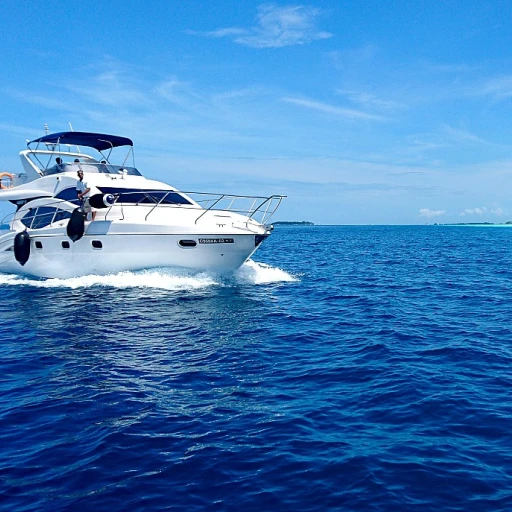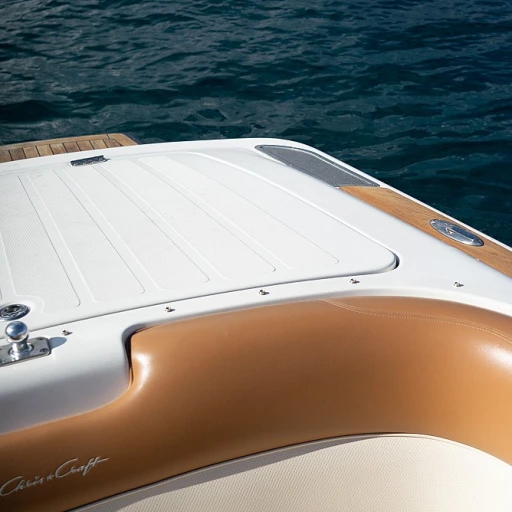-large-teaser.webp)
Understanding Roller Furling Twin Luff Foil
The Evolution of Roller Furling Systems
Roller furling systems have significantly evolved over the years, revolutionizing the way sailing aficionados manage their sails. Among these, the twin luff foil system stands out as an innovative solution designed to enhance performance and ease. But what exactly is this system, and why should you consider it for your sailing adventures?
The roller furling twin luff foil is essentially a technology that involves using dual tracks or grooves to manage two headsails simultaneously. Unlike single line roller furlers, this system allows for more efficient sail handling, particularly useful for those competing in races or looking to optimize their sailing experiences. With the dual track configuration, swapping sails becomes a much smoother process, whether you're dealing with a jib or a genoa. This not only saves time but also improves the overall sailing performance.
Comprised of components like the roller furler drum, luff tape, and the foil unit, these systems are strategically installed along the head sail, allowing sailors to smoothly manage their sails from the safety of the deck. One of the key features, the carbo racing foil, is specially designed for racing enthusiasts who demand high performance from their sailing systems.
Investing in a twin luff foil system, such as the ones from renowned manufacturers like Alado or Harken, ensures a combination of durability and reliability. These systems cater to varied sailing needs, whether you own a small cruising yacht or a larger racing vessel. The extrusion length and size of the boat will typically determine the precise specifications of the foil set required.
Furthermore, the roller furling twin luff foil system introduces a layer of versatility, allowing for a seamless transition between the existing sail configurations. This could include the use of both a headsail and a second sail for optimized wind harnessing. The luff grooves are engineered to accommodate luff tapes of different thicknesses, offering flexibility across numerous sail designs.
Maintaining your system is crucial for longevity and performance. Keeping the luff system in top condition ensures that sailors can continue to enjoy the benefits of this modern technology. For those interested in delving deeper into maintaining and optimizing their yachts, exploring relevant maintenance techniques can be incredibly beneficial.
Advantages of Using Twin Luff Foil Systems
Elevating Performance and Ease
When it comes to achieving superior sailing performance and ease of operation, the Twin Luff Foil system has clear advantages. Whether you're engaged in a leisurely cruise or pushing your limits in a competitive race, the benefits of transitioning to a roller furling system are notable. Let's delve into how these systems enhance your sailing experience.Simplifying Headsail Changes
One of the most significant advantages of the Twin Luff Foil system lies in its ability to make headsail changes virtually seamless. The twin groove design enables easy transitions between sails, allowing sailors to adapt quickly to changing wind conditions. With this system, you can efficiently manage your jib, eliminating the old cumbersome deck work.Improved Sail Shape and Performance
Designed to enhance sail shape, the Twin Luff Foil's luff groove configuration ensures a minimal reduction in aerodynamics when the headsail is unfurled. As a result, sailors often experience improved speed and overall performance. Offering better support, the dual luff setup eliminates the need for traditional halyard tensioning, thus optimizing the jib's power.Perfect for Racing and Leisurely Cruising
Carbo foils, racing foils, and carbo racing units incorporated in these systems cater specifically to both racing and recreation. They provide the flexibility to host multiple sails, such as a second sail or a racing sail, without the need to remove presents sails. The extrusion length and click expand foil set options further customize your experience, enhancing efficiency.Boosting Boat Safety and Control
Safety remains a top priority on any size boat, and here, roller furling systems excel. The option to quickly furl sails reduces crew demands and stresses on the boat under adverse conditions. The modern drum and foil setup enable safer handling, ensuring a controlled and enjoyable sailing experience for all onboard. To understand more about technological advancements in yachts, explore the rich offerings and services available through renowned marine facilities like the insights shared here. These locations play a pivotal role in embracing cutting-edge improvements that enhance the safety and performance of modern boats.Comparing Traditional and Modern Furling Systems
Exploring the Evolution of Furling Mechanisms
Sailing technology has come a long way, with innovations constantly evolving to ensure a seamless and enjoyable experience on the water. The transition from traditional to modern furling systems genuinely showcases this progress. The traditional furling methods primarily revolved around manual improvements, leveraging mechanisms such as the jib and headsail foils. While these systems were efficient for their time, they required a great deal of physical effort. Sailors often had to manage the halyard, furling drum, and tuff luff all manually, demanding both skill and experience. Enter modern furling systems, which have revolutionized the art of sailing. Today, systems like the Alado and carbo foil units offer a more streamlined, efficient approach. These advancements feature roller furling technologies that have significantly reduced the need for manual operation. With roller furler drums, sailors can easily manage the luff groove and extrusion length with precision. What's fascinating about modern systems is their adaptability. They are designed to work seamlessly with existing sail configurations, whether it's a standard headsail or a high-performance racing foil. Dual luff systems, for instance, can accommodate both a primary and second sail without compromising on speed or agility. Moreover, the integration of carbo racing foils further enhances the sailing experience, particularly for racing enthusiasts. These lightweight systems are robust yet delicate in working the deck, ensuring smooth transitions during high-pressure races. For those invested in understanding how these technologies enhance the racing and cruising journey, click expand to delve deeper into how modern furling systems measure against their traditional counterparts.Installation and Maintenance Tips
Seamless Installation for Optimal Performance
When it comes to enhancing your sailing experience with a roller furling twin luff foil system, proper installation is crucial. Ensuring that each component is correctly fitted will not only optimize the system's performance but also extend its longevity. Here are some key steps and tips to keep in mind during installation:
- Evaluate Your Boat's Needs: Assess the size of your boat and the type of sailing you engage in regularly, be it cruising or racing. The length and type of luff foil you use should align with your specific needs. For instance, a carbo racing foil may be more suitable for racing enthusiasts.
- Choose the Right Luff Groove and Tape: The compatibility of the luff groove and luff tape is essential. They should fit seamlessly with your existing sails to provide a smooth furling action. This ensures that both the headsail and second sail operate efficiently without added strain.
- Install with Precision: Careful installation of the drum and foil unit on the deck is essential to avoid performance issues. Make sure that the extrusion length is suitable for your head sail. Using the appropriate tools to secure each roller and click expand fittings can prevent later adjustments.
- Secure the Halyard: Proper tension on the halyard is critical to maintaining the correct luff system alignment during sailing. This step is crucial in preventing common issues like sail sagging or excessive strain on the luff foil.
- Check Compatibility with Existing Systems: If upgrading from a traditional system, confirm that the new foil set integrates effectively with existing sail configurations and deck hardware for a seamless transition.
Maintenance Tips for Longevity
Once installed, regular maintenance will keep your roller furling twin luff system in top condition. Staying proactive with maintenance not only preserves your investment but enhances your time on the water.
- Regular Cleaning: After each sailing excursion, rinse your furling system with fresh water to remove salt and debris. This prevents corrosion and buildup that can impede the roller's smooth motion.
- Inspect for Wear and Tear: Periodically examine the luff tape, drum, and foil unit for signs of wear. Replacing damaged parts early can prevent more significant issues. Pay special attention to the foil groove, as debris can accumulate and hinder performance.
- Lubricate Moving Parts: Apply appropriate lubricants to moving components such as bearings and the roller furler. This ensures ease of operation and reduces friction that can lead to wear.
- Store the System Properly: When not in use, securely stow the furling system to avoid unnecessary exposure to harsh weather conditions. Protecting your investment when the boat is not in use significantly extends its life.
By following these installation and maintenance practices, you’ll ensure that your roller furling twin luff foil remains in excellent condition, providing years of smooth and reliable sailing adventures.
Innovations in Furling Technology
Breaking New Ground in Furling Technology
The world of sailing continually evolves, pushing the boundaries of what's possible with innovative technologies. Roller furling twin luff foil systems are at the forefront of this evolution, offering sailors unprecedented ease and performance. These systems now incorporate several groundbreaking advancements that enhance both the experience and the efficiency of sailing.- Advanced Materials: Modern furling systems utilize cutting-edge materials like carbo foil and dual luff configurations. These materials provide not only strength and durability but also lightweight properties that improve the boat's performance and responsiveness.
- Enhanced Control Mechanisms: Innovations in drums and halyards mean that adjusting your sails, whether it's furling or unfurling the headsail, is smoother and more controlled than ever. This precision allows for more efficient sail handling, crucial for racing applications.
- Improved Luff Systems: The development of racing foils and carbo racing systems enhances the foil set design, ensuring that headsail foils and jib tension adapt dynamically to wind conditions. This flexibility allows sailors to maintain optimal sail shape, thus maximizing speed and agility on the water.
- Modular Installation: Today's furling systems offer more flexibility in installation, accommodating different extrusion lengths and size boat specifications. This modularity allows sailors to customize their setup in alignment with the specific needs of their journey, whether it involves racing or leisurely cruising.
Expert Insights and Recommendations
Gaining Insights from Seasoned Sailors
When it comes to enhancing your sailing experience, expert insights can be invaluable. Many seasoned sailors advocate for the roller furling twin luff foil system due to its efficiency and ease of use. The ability to quickly adapt to changing wind conditions without leaving the deck is a game-changer, especially during competitive racing or long voyages.
Recommendations for Optimal Use
Experts suggest that the key to maximizing the benefits of a twin luff foil system lies in understanding your boat's specific needs. Consider the size of your boat and the typical sailing conditions you encounter. A well-matched furling system can significantly improve performance and ease of handling.
- Choose the Right Size: Ensure the extrusion length and foil unit are appropriate for your boat's dimensions.
- Regular Maintenance: Keep the drum and halyard in good condition to prevent wear and tear.
- Consider the Racing Edge: For those into competitive sailing, a carbo racing foil or dual luff system can provide a significant advantage.
Future Trends and Innovations
The world of sailing is ever-evolving, and the same applies to furling technology. Innovations such as the tuff luff and carbo foil systems are gaining popularity for their enhanced performance and durability. The industry is moving towards more user-friendly and efficient solutions, making sailing more accessible to enthusiasts of all levels.
As you explore these options, remember that the right system can transform your sailing experience, making it more enjoyable and efficient. Whether you're a seasoned sailor or a newcomer, investing in the right furling system can make all the difference.













